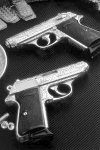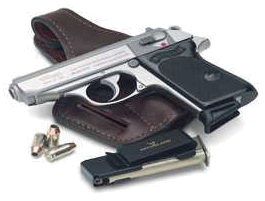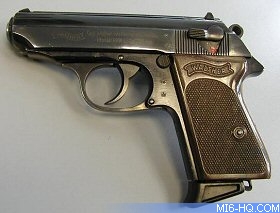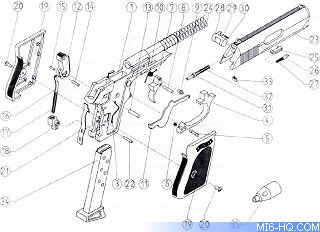
|
| |
History of the Walther PPK
10th May 2004
The Walther PPK became one of the world's most famous guns after 007 put one in his holster...
|
|
The armourer, Boothroyd, had been played by Peter Burton in
Doctor No, and had supplied Bond with his legendary Walther PPK.
Boothroyd (he was not credited as Q until Thunderball) and was
in fact a character from Fleming's Dr No, in which he is responsible
for kitting 007 out with a Walther PPK to replace his Beretta.
 |
|
This was because in a letter Fleming was
corrected by a Glasgow guns expert, Geoffrey Boothroyd
who wrote, 'I
like
everything about your James Bond except his deplorable
taste in weapons. A Beretta 22 is utterly useless as well
as being
a lady's gun - and not a very nice lady at that!'.
Fleming
rectified the oversight, and the Walther PPK became
Bond's gun of legend. |
In 1931 when the model PP was the main production weapon, Walther
introduced a pocket version. The gun was the same as the PP except
that the barrel had been shortened. The internal mechanism was
the same, however the parts that were affected by size were of
course different. The most significant change was in the frame.
The total length of the PPK is 155 mm. The magazine holds one
less cartridge. The barrel has six clockwise riflings. The back
strap had been eliminated. They utilized a wrap-around plastic
grip to give the frame a corrected contour. The firm then came
up with the model designation PPK or "Polizei Pistole Kriminal".
The name symbolized that it was to be used for covert undercover
police work.
The PPK was highly praised because of its compactness and
reliability as well as the unique signal pin indicating that
the gun was either loaded or unloaded. It protrudes from
the rear of the slide when the chamber is loaded.
If the
chamber is empty it stays inside the rear slide. This
loaded chamber indicator does not exist on the rim fire
models,
only the center fire guns.
Right: A classic Walther PPK |
|
 |
The PPK was readily suited for undercover and intelligence work.
It was compact, reliable and of reasonable stopping power. Many
of the post-war intelligence agencies standardized on the PPK.
In addition to MI5 and MI6, the PPK has been used by German BND,
Frances' SDECE, Israel's Mossad and Switzerland's Intelligence
and Security Service. The Chinese intelligence service actually
issued a PPK clone.

Above: An explosive cut-away of the parts that make a PPK |
|
After the World War II, both the PP and PPK were manufactured
outside of Germany by the French firm Manurhin under the
license from Walther. Only some design documents, which had
been barely salvaged, served as start-up capital.
As a result
of the lack of production capacity and the prohibition
of manufacturing, the decision was made to grant licenses
for
the production of various products. Walther was not able
to begin manufacturing again until 1957. |
After the 1968 Gun Control Act went into effect and the PPK
was barred from import, diplomatic pouches from Germany often
bulged with brownish-red Walther PPK boxes. The GCA prohibited
the importation due to the size of the gun. Under the legislation,
a pistol must earn a number of points for various sporting features.
The PPK could not earn the required points. The Walther firm,
not wanting to lose US sales of the PPK, developed the PPK/s.
By combining the frame of the PP, which was deeper than the PPK,
and the slide of the PPK, the PPK/s was born. The PPK/s met all
of the requirements for a handgun to be imported into the United
States.
The PPK/s was first manufactured in the United States
in 1978 by Ranger Manufacturing in Gadsen, Alabama.
Today the PPK and the PPK/s are both manufactured with
the .380 ACP or 9mm Short standard. Those that still own
the 7.65 guns have found that the newer .32 ACP Silvertip
loading from Winchester still offers more than adequate
stopping power.
The Walther PPK or PP are still best carried with .380
ACP loads, a good personal defence caliber. This is provided
that the shooting range is short. Only the American models
have been produced in stainless steel. The German handguns
are made with the blued finish. |
|
MI6 Datastream
Country Of Origin: Germany
Designation: Pistol
Cartridge: 6.35 mm Browning, 7.65 mm Browning, 9 mm Short
Production Date: 1930
Length: 148 / 155 mm
Barrel: 80 / 83 mm
Weight: 580 / 590 g
Rifling: 6 grooves, rh
Capacity: 7 rounds
|
|
Now the Brosnan era of Bond films has ushered in the next generation
from Walther, the P99...
Related Articles
 Q-Branch
Section
Q-Branch
Section